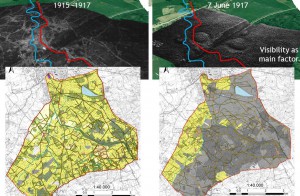(November 5-7th 2014)
Non-invasive landscape archaeology of the Great War as baseline for an integrated heritage management
The commemoration of the World War I increased the attention to the Great War in research, policy, application and public awareness. Several research initiatives and inventories of the military heritage are set up, cultural and tourist visits are a booming business, and regional authorities are initiating sustainable heritage management and activities paying attention to the distinctive military features and landscapes. However, to unravel the complex reciprocal interaction between landscape as the last witness and the ware activities in time and space, an interdisciplinary approach is appropriate.
The paper will present two cases of inter- and transdisciplinary research related with landscape and World War I heritage. The first case is situated in the former battlefields and hinterland of the Great War in Belgium, where a interdisciplinary research project is set up with the overall question how the buried heritage of a former war zone within the present landscape can be characterised using a non-invasive methodology. The landscape archaeological project combines three different disciplines: remote sensing archaeology, geophysical soil sensing, and historic and visual landscape analysis, which are all go beyond the current state-of-the-art within the disciplines as well as enriching each other to come to an integration of knowledge acquired within these disciplines toward an interactive cartographic assessment model.
The second case is a World War I defensive trench line in the north part of Flanders, where a detailed inventory of the military relics and landscape formed the baseline to formulate an over-all vision for sustainable future cultural management of the militarized landscape. This research developed into the implementation of the conservation of these areas and razing awareness in a transdisciplinary way.
Veerle Van Eetvelde, Stephanie Verplaetse, Wouter Gheyle, Birger Stichelbaut, Jean Bourgeois, Timothy Saey, Marc Van Meirvenne
